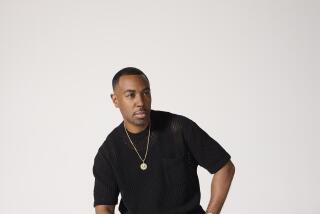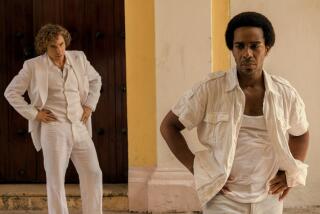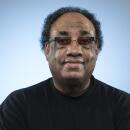TV With an Attitude : The language and rhythms of today’s black youth culture are ready for prime time, but what message is being sent?
T. V.J.!!!!!! GIMME THAT BEAT!
The Homeboy Shopping Network is chillin’ on the box. Wiz and the Iceman, the hustling homeboy hosts, are on the mike, bragging to viewers about the great bargains they’re selling from a truck loaded with stolen goods.
“We got car phones, we got car stereos, we got car alarms,” the Iceman boasts.
Adds Wiz: “Yeah, and if you act now, we can probably get the car.”
B-B-BUST THAT F-FU-FU-F-F-FUNNY MOVE!!!!
The Fresh Prince is in the kitchen of a Bel-Air mansion, teaching his young, upper-crust cousin how to put more spunk in her funk, more glide in her stride.
“Less like George Michael, more like (M.C.) Hammer,” instructs the Prince, demonstrating with a twisting thrust. “Look, baby, you’ve got to put more butt into it.”
NOW PUMP IT UP!
Thirteen-year-old Lester is dissin’ his black father and white stepmother on their plans to eat “Ray,” a turkey he has befriended in their Baltimore home, for dinner. “Y’all wanna snuff my main man?” he moans. “That’s a zip down on the flip side.”
CAN’T TOUCH THIS! BUT YOU CAN LAUGH AT IT!
To some observers of the new television season, the infamous philosophy of revered soul poet Gil Scott-Heron may appear to be coming true: The revolution is being televised. And it’s something of a laughing matter.
The language and rhythms of young inner-city life are moving from the boom boxes of teen-age cruisers into the square boxes of America’s living rooms. Sparked mostly by the growing crossover popularity of rap, the staying power of NBC’s youth-oriented “A Different World” and the popularity of Arsenio Hall’s syndicated talk show, television comedy is increasingly becoming more black--and white--and rap all over:
* Fox’s “In Living Color,” the first network comedy-variety show with an African-American perspective, has earned critical acclaim and an Emmy Award.
* “The Fresh Prince of Bel Air,” a comedy about a teen-age rapper transplanted from the mean streets of Philadelphia to a Bel-Air mansion, was hailed during the preseason by NBC program executive Brandon Tartikoff as the show that the top-ranked network felt would secure its No. 1 status.
* “True Colors,” a new comedy about an interracial family on Fox, features a black teen who bewilders his white grandmother with rap lingo.
* Even the soft-edged “The Cosby Show” is featuring new teen characters that network executives admit reflect a more street-wise attitude than the regular Cosby family members.
Hip-hop has gone High Concept.
Most observers eyeing the new trend say network television is trying to hook young audiences reared on MTV while offering adults a unique, fast-paced cultural perspective. It’s another way to try to stop viewership from further erosion, they say.
Warren Littlefield, president of NBC Entertainment, said that his network and others are tapping into what’s current and happening. “We’re always trying to push ourselves and be relevant--that’s what television has to be,” he said. “I think all these shows are trying to pick up on this urban sensibility.”
But the question has also been raised by media experts, sociologists and some entertainment industry executives about whether viewers are actually getting a raw deal with the raw comedy.
“Network television has taken something current and hot, and is trying to wring all the value out of it,” said Sherrie Mazingo, a USC journalism professor specializing in social aspects of the mass media. “But they haven’t put enough thought and substance into it. It’s just one-line premises.”
She and other critics contend that television, because of its commercial nature, is just skimming the surface of the young and vibrant African-American culture, and has largely watered down or diluted the dynamics of the material it hoped to celebrate.
“It’s always a step forward when television goes beyond Jack Benny’s Rochester or Stepin Fetchit, but it’s difficult for television to reproduce an accurate sensibility,” said Gerald Horne, chairman of the black studies department at UC Santa Barbara. “Perhaps the writers of these shows have problems getting certain perspectives past the standards and practices committee. Perhaps that accounts for the inability to accurately capture that sensibility.”
Some watching the urban-tinged shows say they are pleased to see African Americans depicted in a more realistic and favorable light than they were in such 1970s and 1980s shows as “What’s Happening,” “That’s My Mama,” “Sanford and Son” and “The Jeffersons”--or even in current series such as ABC’s “Family Matters.”
“In Living Color” is cited by several sociologists and academicians as the most accurate and effective in reflecting the diverse attitudes and culture of Africa-Americans. But they added that the improvement in the general images presented is not enough, and could, in fact, be sending a dangerous message to viewers.
“We still live in a segregated society, and the images on television don’t always represent a broad spectrum,” Horne said. “Maybe it should. I know that there was a certain environment that produced Rochester and ‘Birth of a Nation,’ and that environment still exists. There could come a time when all we have is distorted images or no images at all. It would be naive to rule that out.”
Charges of the perpetuation of negative racial and sexual stereotypes have been leveled against “In Living Color.” “Fresh Prince”’ has been criticized for its attempt to squeeze a rapper into a conventional “fish out of water” sitcom format. “True Colors” has been knocked as not going far enough in dealing with the obvious tensions of such an interracial union.
On the other hand, some TV viewers feel that some of the rap-tinged humor has already gone too far. James Carrey, the only white male member of the “In Living Color” troupe, said that he was once approached by a white fan who said that he wished the show would “knock off the black (stuff).” Rosie Perez, who choreographs the show’s “Flygirls,” said that a major record company executive warned her when she was first hired that middle America would not cater to hearing rap music during the frenetic dance routines.
Entertainment industry insiders and outsiders say the timing of the new trend probably has more to do with economics than social awareness.
“The success of ‘In Living Color’ made it obvious to network executives that blacks on television can make money,” said Franklin Ajaye, a comedian and actor who wrote for the show during its first season. “It also has a lot to do with Madison Avenue. When they started putting rappers in ads, that sealed it.”
Herman Gray, associate professor of sociology at Boston’s Northeastern University, pointed out that the networks were establishing the shows “at a time when there is a decline in viewership. They need a new market. And the clothing and music of young urban African-Americans has a proven crossover appeal to suburban white kids, so there is definitely a move by the networks to get a new audience.”
“Fresh Prince” creators Andy and Susan Borowitz said that the new hip-hop trend was also a response by network executives to the deteriorating popularity of the standard family-oriented comedy that reached its peak in the 1980s.
“It was a white, middle-class kind of comedy, but it’s losing share points,” Susan Borowitz said. “If it wasn’t skewed for older audiences, it was being written by older people for younger audiences, and that doesn’t work.”
NBC programming chief Littlefield had said in a previous interview that the network had been inspired to produce a rap-oriented show by cover stories about rap in Newsweek and Time magazines, and by “Yo! MTV Raps.” “I was . . . feeling waves of something new and contemporary running through various streams of culture in America. We felt there was a drum beat going on out there, and we looked at our development (schedule) and said, ‘It’s not represented,’ ” he recounted.
Many rappers appear to be happy with the dawning of the hip-hop TV age. Popular rap artists hang out at tapings of “In Living Color” and “Fresh Prince.” They beg to have their records played during “In Living Color’s” dance segments. The tapings have a party-like atmosphere. Audience members rap in their seats and dance in the aisles.
One person who is not surprised by the emergence of “hip-hop” comedy, and the breakthrough success of “In Living Color” in particular, is Keenen Ivory Wayans, the show’s creator, executive producer, co-writer and co-star. He believes that even though his program has a black perspective, the appeal cuts across several age and ethnic groups.
Following its debut on Easter Sunday last April, “In Living Color,” which airs Sundays at 8 p.m. on Fox, earned mostly high praise--and an Emmy Award for best comedy/variety series--for its pointed, irreverent sketches. The show has also been praised for its biting, sometimes brutal parodies of celebrities such as Whitney Houston, Michael Jackson, Mike Tyson and Ted Turner.
“I knew it would catch on,” Wayans said. “I always had a good feeling about it. It was different, but I knew people would watch it if it was funny. It has the same appeal as hip-hop or rap. It’s hip-hop TV, but it’s something that reaches the masses.”
Exactly what message the masses are getting, however, is the subject of an escalating debate.
NBC’s “The Fresh Prince of Bel Air” is the most-hyped and most controversial--attempt by network television to get into the groove. It premiered with what many felt were admirable credentials. Music producer and composer Quincy Jones is a co-executive producer. Noted African-American playwright and actor Samm-Art Williams is a producer and writer. Actress and choreographer Debbie Allen directed the pilot and other episodes.
The show revolves around Will, an inner-city teen from Philadelphia (played by real-life rap star Will Smith of D.J. Jazzy Jeff and the Fresh Prince) who moves in with his stuffy, wealthy relatives in Bel-Air to escape from getting into trouble with the homeboys back home.
Will’s street smarts frequently clash with the country-club values of his family, who, for the most part, seem to have lost touch with their cultural roots. The family and butler are mystified, bewildered and, at times, horrified by Will’s antics and lingo.
One of the main targets of Will’s barbed wit is his pompous, Ivy League college-bound cousin Carlton (Alfonso Ribeiro), whose main enjoyment in life appears to be a good game of golf:
Carlton (offering the Prince a snack): What do you say to an Oreo?
Will: I say, ‘Whassup, Carlton?’
Will’s new environment and his enrollment at the fictional Bel Air Academy also puts him into conflict with his old street-wise friends. During a recent episode, Jeff (Jeff Townes, a.k.a. D.J. Jazzy Jeff) interrupted Will, who was working on a poem for the poetry club:
Jeff: Man, I got this new Ice Cube tape. It’s dope .
Will: I ain’t got time for that. I’ve got to finish this poem.
Jeff: Poem? Then what you gonna do? Bake some cookies? Hem a dress?
What sold NBC on the show, Littlefield said, was Smith. “When I was looking at a tape of the Fresh Prince and his music video, there was just something electrical that was jumping out,” he said. “It was his personality, it was his attitude. It was a hip character attitude of the kind that had not been on network television.
“We thought, ‘How do we package that sensibility? The sensibility was so wildly entertaining.’ We thought to put it in a world that didn’t understand it.” He noted that the program was not so much a showcase for rap as it was a showcase for Smith.
But “The Fresh Prince” has not been the critical or ratings hit that NBC executives had predicted. Critics of the show have included some in the cast and crew of “In Living Color,” who felt Smith was appealing, but that the concept had more gloss than substance.
They are not the only ones blasting the show.
Other media watchers have attacked the Fresh Prince character as a barely disguised version of the “J.J.” character on the 1970s “Good Times” television show. J.J. (Jimmie Walker) was the focus of heavy criticism by blacks, who described the depiction of his cartoonish demeanor and mock bravado as insulting and unrealistic, especially in a show about a struggling family living in a housing project.
Sociologist Gray, who is working on a book dealing with African Americans in commercial television, said that “Fresh Prince” reflects an unfortunate dulling of the rap culture.
“It really does tame much of the very rap sensibility it wants to celebrate,” Gray said. “I think they lost courage. This was a grand opportunity to take rap seriously, to see what the internal sensibility was. But once a concept like that gets into the machinery of television, it just gets too hard to combine the two elements.”
USC’s Mazingo said of “Fresh Prince”: “It’s dumb. It’s stupid. It’s insulting and demeaning, idiotic and flimsy.” She said that it represents “the perpetuation of the classic stereotype throughout literature and popular culture of the black as buffoon, as the comedic clown.”
Mazingo, a former NBC News editor and producer, considers the show’s premise to be its main problem. “The premise is unbelievable,” she said. “It says you can take a kid of the ghetto, plunk him in Bel Air, and the values will fit together comfortably. That is not real.”
Littlefield disagreed with the critics who charged that the show had watered down rap. “We’re really presenting this character in all forms of his life--in his school life, in his social life,” he said. “I don’t think we’ve compromised there.
“The show is in its early stages, and is still evolving. But the essence is that this family can learn something from him, and he from them. That tension makes it entertaining. He’s not all right, and they’re not all wrong.”
The Borowitzs insist that they are hearing nothing but praise from viewers about the show’s point of view and realism.
“Those people who are unhappy with what we’re doing? They’re not writing us,” Susan Borowitz said. “But we have received lots of letters from viewers for addressing intercultural class awareness. We’ve also received letters praising us for having Will being interested in education.”
Andy Borowitz added, “Teen-agers can smell a fake faster than anyone, and this has become the hottest show in America with teen-agers. That’s a key to how we’re doing.”
Besides, presenting a gritty picture of an inner-city youth is not the object of “Fresh Prince,” the couple said.
“This show will not be just one thing,” Susan Borowitz said. “There will be moments where we will address racial issues. Then there will be other weeks when we just have a great time.”
Andy Borowitz added, “This show will do more if there is a broad-based appeal. You can’t be angry all the time. Otherwise, ‘The Life and Times of Sylvia Plath’ would be the No. 1 show.”
Another new show with a hip-hop element, Fox’s “True Colors,” has drawn basically a “thumbs down” from critics and media observers, despite its breakthrough premise as television’s first comedy series about an interracial family.
In the show, Ron Freeman, a widowed black dentist (Frankie R. Faison) with two teen-age sons, confronts life in Baltimore with Ellen Davis (Stephanie Faracy), a divorced white kindergarten teacher, her teen-age daughter and her grouchy mother, Sara (Nancy Walker), who doesn’t care for her new son-in-law.
The Davis character summarized the family’s problems in the pilot episode:
Ellen: We’ve got two different families, three generations and two races, not to mention a woman who hasn’t smiled since the Dodgers left Brooklyn. One day we just said to these people, “Surprise, you’re a family.” . . . It’s a wonder the house is still standing.
Much of the humor on the show, which airs Sundays at 7 p.m., comes from the interaction between Lester, the hip-talking youngest son (Adam Jeffries), and Sara:
Lester: Yo, Grandma. Check this out. Yesterday, I was shootin’ some hoop over in the project, right? And this dude come up to me and say, ‘My main man, let’s do for some change,’ y’understand? So I say, ‘Homes, let’s go.’ So we’re mixin’, right? And WHAM! BAM! Man walks home with his jive and I walk home with his five. Can ya dig that?”
Sara: That’s very nice. (Turns to Ron.) What the hell did he say?
The show is languishing near the bottom of the ratings. Michael J. Weithorn, the creator of “True Colors” and a former producer of “Family Ties,” said that the new awareness of hip-hop culture had changed expectations of what his show should be, and, ironically, has hurt it.
“In the past few years, America has become more comfortable with a more honest, edgier presentation of black culture,” he said. “Before, television executives were concerned that blacks had to be unthreatening. Anything else was unacceptable.”
Weithorn said he had basically just wanted to make “True Colors” a comedy about conflicts between personalities, not racial tension. But he said that he may have made a mistake in making his new family too comfortable with each other and their situation.
“Now I want to bring in more of a raw edge, but I don’t want it to be gratuitous,” he said. “I don’t want the viewer recoiling.”
But it may already be too late. Mazingo said that many conservative viewers would already be turned off by the program’s premise, and that the rap element would not bring in younger or more liberal viewers.
Although many inside and outside the industry are predicting imminent cancellation of “True Colors,” the verdict is still out on how effective “The Cosby Show”--often criticized by blacks as presenting what they feel is a homogenized and sugar-coated view of African-American family life--will be in pumping up the volume.
“Cosby” a few weeks ago introduced Cousin Pam (Erika Alexander), a 17-year-old inner-city youth who is a niece of Claire Huxtable (Phylicia Rashad).
Her first brush with the Huxtable lifestyle came when she tried to persuade Cliff Huxtable (Cosby) to allow her to go visit her “homies . . . uh, friends” in the Bronx at a late-night party. Cliff raised his eyebrows when Pam said “homies.”
Pam’s friends attempted later in the program to get Pam to break curfew and go to the party. But everyone wound up spending the evening with the Huxtables, happily drinking cranberry juice.
The attempt to make “Cosby” a tad grittier was not lost on the writers of “The Fresh Prince.” A recent episode showed Will remarking on the development as he scanned a TV Guide: “Ooooooooh!!! Bill Cosby has a street-wise niece coming on the show. That should be decent !”
A one-hour episode scheduled to air last Thursday focused on Pam, her friends and the community center where they hang out. “It’s fresh territory we haven’t been in before,” Littlefield said. “Pam has friends who are clearly more street-oriented than the Cosby family is.”
He maintained that the new urban emphasis was a natural one for “Cosby,” and was not inspired by criticisms.
“Every successful series, when it’s in its senior years, develops and expands,” Littlefield said. “It’s just a natural place to do this now.”
The depiction of young inner-city culture in future network television shows will be largely determined by the success of the current programs, academicians and media experts say. But some added that they do not foresee future efforts being significantly more realistic.
“There will be more rap-oriented shows, but I think they will eventually disappear,” Mazingo said. “They are a fleeting phenomena. The way they are now, they are not substantive enough to hold the attention of the target audience, which is young black adults, or other segments of viewership. So the networks will move to something else.”
“It can go either way,” Gray said. “But I think there’s a movement towards diversity, particularly in the state of California, where the television industry is based. To the extent that climate gets stronger, television may put forth more positive images.”
The worst-case scenario, he said, would be if the shows continued to be “watered down and normalized. But the culture will keep moving, it will always keep moving. It is dynamic. And television will not be able to deal with that until the medium is much more open.”
More to Read
The complete guide to home viewing
Get Screen Gab for everything about the TV shows and streaming movies everyone’s talking about.
You may occasionally receive promotional content from the Los Angeles Times.







